Porcelain Crowns Los Angeles
Dr. Anthony Mobasser is a porcelain crowns Specialist in Los Angeles CA. He has completed over 10,000 crowns successfully, which are still looking incredibly beautiful, and most importantly lasting over 30 years in his patient’s mouths and still functioning perfectly. He is known to be an expert dentist in crowns, and full mouth reconstruction with porcelain crowns, because his porcelain work looks amazing and function well for many years.
Synopsis:
Are you unhappy with your smile, especially if you have a darkened tooth due to a root canal? You’re not alone. Our recent patient felt the same way and dreamed of a brighter, fuller smile.
Good news: we turned that dream into reality! In just one week, we transformed their smile using a personalized mix of porcelain crowns and veneers. Our focus? A natural, white look that complements your unique features. We ensure each crown and veneer is tailored in color and shape, guaranteeing not just beauty but perfect function.
Your bite and occlusion matter to us! If you’re considering a smile makeover, remember, it’s not just about looks. It’s about confidence, comfort, and quality of life.
Ready to see how a smile makeover can change your life? Schedule a complimentary consultation with Dr. Anthony Mobasser today and take the first step towards the smile you deserve!
Dr. Mobassers’ Los Angeles private dental practice, which caters to Hollywood stars and Beverly Hills celebrities is known for his artistry in designing knock-out smiles with the use of porcelain crowns if need be. He has earned the reputation of dentist to the stars when it comes to full mouth reconstruction with crowns and veneers to transform a mediocre smile into a red carpet-ready smile.
For many years, patients’ demands have been increasing for improved aesthetics in dental ceramic restorations, particularly in the area of front teeth that require Porcelain crowns or caps. The idea of “All Natural Crowns” has seen growing demand. Ceramic crowns do not show metal substructures under them as opposed to PFM (porcelain fused to metal) crowns, and they can be stronger than PFM crowns if using Emax or Zirconia type porcelain.
Per Dr. Mobasser, it is important for patients to know that some ceramic crowns such as Lava or Zirconia, are metals, but they are ceramic metals. Because they are ceramic metals, they are white opaque in color, and it is not always the best solution to use for front teeth unless the dentist is working also with a skilled ceramist.
Zirconia porcelain, however, can mask discolored metal posts, or other dark areas of the tooth, on most occasions up to 90%, but not 100% due to previous root canal procedure. The only crown that can mask 100% dark color due to a metal post or root canal treatment done on a tooth is PFM crowns. No other type of crown can come close to it!!
Porcelain Crowns on Two Front Teeth

Transformed a smile with innovative pink porcelain: Addressing severe gum recession, we artfully crafted gum tissue over a porcelain crown and dental veneer.
By tailoring the color and reshaping the two front teeth, we provided our patient with a stunning and priceless smile makeover.
What Are Zirconia Crowns or Lava Crowns, Pros and Cons?
As of 2017 Zirconia can be milled, and cannot be pressed, also the Zirconia crowns are usually cemented and cannot be bonded, if the retention of the prepared tooth is compromised, the dentist cannot bond, and only cement, meaning the crown can come off.
This is one negative feature in regard to Zirconia for either partial coverage restorations or full coverage restorations such as Zirconia or Lava crowns, on the plus side, they are extremely strong and fracture-resistant if they are made monolithic.
The cons of Zirconia or Lava crowns is the fact that the dentist will be having a hard time adjusting them and polishing them in the mouth. The expert dentist must have a great master ceramist to give the final crown perfect in regard to color and the patient’s bite. Zirconia crowns can cause wear of opposing teeth if they are not polished properly.
Before and After Porcelain Crowns Front Discolored Tooth


What Are Emax Crowns Benefits and Disadvantages?
Another type of porcelain crown is Emax (Lithium Disilicate) crown, which they are also a ceramic-metal and extremely durable, however, they are not as opaque as Zirconia but translucent, so if the underlying color of the prepared tooth is dark, they will show the color through, however they are still amazingly strong and nice if the color of the underlying prepared tooth is natural dentin.
Emax crowns can be cemented or bonded which is a benefit over Lava (Zirconia) crowns, and they tend to be more natural-looking as opposed to the bright white look of Lava or Zirconia crowns.
The benefits are ease in adjusting the Emax vs Zirconia to the patient’s bite, and an easier method to polish up the Emax crown vs Zirconia crowns. Their natural translucent color is beneficial over opaque Zirconia crowns, although nowadays with an expert Ceramist, translucent Zirconia crowns are available.
They are for patients who more like to have a more natural white vs opaque white-bleached teeth smile. They are strong enough but not as strong as the monolithic Zirconia crowns, which are the hardest to fracture.
What Are Different Types of Porcelain Crowns?
PFM or porcelain fused to metal crowns do contain metal substructures such as gold, precious, or non-precious metals for strength, and still, to this date, there is the place for them in cosmetic dentistry if done properly. They are best to mask the dark color of the metal posts or the dark color of tooth structures. PFM crowns will block out 100% of the underlying color of the tooth, as compared to the ceramic crowns.
The use of which type of Porcelain Crown to be used for the patient is the duty of an expert dentist and is of utmost importance. With the advent of Lithium Disilicate, Zirconia, and Leucite Porcelain Crowns, Empress or Authentic crowns each are indicated for a specific reason. Per Dr. Mobasser each have their own indication, depending on numerous factors which relate to cosmetic and function.
Make sure to ask Dr. Mobasser which type of crown best fits your needs, after a complete evaluation?
Dr. Anthony Mobasser has incorporated dental Porcelain Crowns including LAVA, Emax, BruxZir where no metal substructure is required, and the strength is not compromised; however, Emax, Lava, or BruxZir must be used judiciously, as the individual’s bite, compatibility, and the cosmetic needs and the occlusion play a major factor for choosing the correct crown to last a long time.
Generally speaking, Zirconia crowns are stronger than Emax crowns, however, Emax crowns are prettier and more translucent than Zirconia, to top it off, the most Aesthetic porcelain is leucite reinforced or feldspathic porcelain, but they are the weakest in strength! That is why an expert dentist must evaluate your bite (occlusion) AND your cosmetic needs, prior to deciding which type of crown is best for you!
Zirconia Crowns such as Lava are also used on dental implant abutments for strength mostly, and the biggest benefit is the preservation of tooth structure, and require less preparation of the tooth structure, which is the biggest plus, however, they DO NOT LOOK VERY AESTHETIC, since they are more opaque material and reflect the light.
The patient’s bite, opposing teeth, and the grinding and bruxing habits of the individual must be considered before choosing a Zirconia crown, which can damage and wear down the opposing tooth consequently a nightguard or a splint becomes a must.
What about the gums symmetry prior to having a Crown Procedure?
If the gums of your front teeth are asymmetrical, it is vital and highly advisable to have gum recontouring surgery or gum sculpting prior to having your front crowns done! Especially if you have a high lip line, or gummy smile, in which your gums show upon smiling. You may see different heights and lengths although the edges of your crowns are perfect. This is usually due to gum asymmetry and gum contouring prior to placing crowns is important.
If you elect not to have gum contouring done with the surgeon, even the most beautiful crowns, will not look good and will show different lengths, although the edge of crowns is even! Ask Dr. Mobasser if you are a candidate for gum contouring prior to having your crowns done?
We can make Custom Crowns as natural as you want vs Hollywood white

Types of How Dental Porcelain Crowns are made?
1- Feldspathic porcelain crown, which is a salt and liquid technique, that goes in the oven to fabricate the porcelain layer. Great skill is required by the ceramist, they look great, and it takes much more man-hours by the ceramist to produce that crown.
2- Pressed Porcelain Crowns (meaning waxed by dental ceramist), which can be done with Lithium Disilicate (Emax porcelain), or Leucite reinforced porcelain (looks great, not as strong compared to monolithic Zirconia). Usually, Zirconia is not pressed but milled in CAD-CAM machines digitally.
3- Milled Cerec crowns, such as CAD-CAM technology which can still be done with Emax, Zirconia, or Leucite reinforced Porcelain.
Patients must understand, that Emax crowns are more translucent in nature, and do not reflect light, as much as Zirconia or Lava, so Emax tends to be more on the gray side vs the Lava or Zirconia crowns which are bright. Zirconia or Emax crowns are so strong that if the bite or the patient’s occlusion is slightly off, it can cause discomfort, especially to the nerve of the teeth. They are extremely hard to remove or redo after they are inserted into the tooth.
As far as color matching to your existing dentition: Emax also does not hide the underlying color of your existing tooth, that is why they do not block outcast post-metal restorations well, and the metal can show thru. The great benefit of Emax and Zirconia is their strength which is 5 times stronger than regular porcelain, at the same time they can wear the opposing natural teeth!
And if they are bonded to your tooth, it is not easy for any dentist to remove these crowns, repair them for recurrent decay, or for any reason to redo them. If the lava or Zirconia crowns are not adjusted to the patient’s bite, that can cause pain to the tooth or possibly cause a root canal problem. These materials do not wear down like your natural teeth and can cause the force of your bite to cause damage to the nerve of your teeth.
Leucite reinforced Porcelain Crowns such as Empress crown, or Authentic crown, are great to color match, to the adjacent teeth, and work very well, but they are definitely not as strong as Emax or Lava Zirconia crowns. It is beauty vs strength.
It is best to consult with Dr. Mobasser to see which type of crown best fits your needs and wants. The bite of the individual patient, whether he or she is a grinder, the alignment of existing teeth, the color of adjacent teeth, your oral hygiene habits, and the cosmetic dentistry needs of the individual will determine which type of crown best fits their needs.
Before & After Dr. Mobasser Porcelain Crown


Indications for Porcelain Crown?
A dental crown or ceramic cap is usually indicated due to cracked or fractured tooth, and when there is not enough tooth structure to hold a large filling or a ceramic inlay or onlay. Usually, on the large mercury fillings or even in large composite tooth-colored fillings, microleakage causes recurrent decays under the fillings which are not evident even in the x-rays, if the support of the tooth is compromised due to remaining tooth structure, or weaker walls of your tooth, it is at that point that dentist may suggest a dental crown. Dr. Mobasser recommends highly that all the existing fillings be removed and a new build-up placed if you happened to need a dental crown to restore your tooth.
Dental crowns are usually recommended after the tooth had undergone root canal therapy since there is no more blood supply to the tooth and the tooth is brittle and dry in which can crack if not protected with a dental crown or ceramic crown.
Why May I need a Dental Post and Crown?
If the tooth to be restored is severely undermined after a root canal procedure and not much enamel and dentin are present, it is advisable to have a Dental Post placed in one of the roots of your tooth for strength to hold before the final crown is cemented to the tooth.
Dental Post can be fabricated in one visit or 2 visits for cast posts. The regular post-build-up is done in the same visit using a plastic fiber post with composite or a metal post with composite for more strength. In case of badly broken-down teeth, an expert dentist usually does a cast post in which the dentist must take an impression inside the canal of the root canal tooth, and have it made to be cemented in the tooth BEFORE placing and shaping the tooth to get a permanent porcelain crown.
This usually takes 2 office visits, and the cost is more than regular post-build-up, but it is much stronger. The cast post and core are usually done with metals such as gold, and the dentist must know how to hide the color of the underlying tooth structure and mask it with a crown. In most cases, this is a challenge if the expert dentist wants to use an all-ceramic crown. Ask Dr. Mobasser how to mask the underlying dark metal or root canal tooth?
Can we shorten a front Porcelain Crown if need be?
The edge of porcelain crowns can be shortened easily and polished to a high gloss. The trick is to reshape the edges to mimic the adjacent teeth, especially if you are doing one of the crowns. It is especially important for the dentist to examine the translucent edge prior to reshaping and go over the pros and cons with the patient. If the front crown is Zirconia monolithic porcelain, the task will be much more challenging due to the strength of Zirconia, and possible chipping later on. It is always a solution if the one tooth is longer than the adjacent one, however, to lengthen a Porcelain Crown, will need to redo the entire crown.
How much is the cost of Dental Crown or Porcelain Crown?
The average cost of Crowns in Los Angeles, Beverly Hills CA, ranges from $1750 up to $4500 or higher. Each cosmetic dentist has a different skillset and knowledge when it comes to Porcelain Crown or any Dental Crown, consequently, the cost of each ceramic crown differs from one dentist to another dentist. Not all crowns are equal from one dentist to another, as mentioned the experience of the dentist, and the knowledge to use what type of crown, and his dexterity is very crucial to the success, beauty, and longevity of the crown.
The second factor is the laboratory he uses, and specifically, the master ceramist he uses contributes to the cost factor. Just like the dentist, the skill set of the master ceramist and his experience are vital. The third factor depends on the material he uses to have your crown bonded or cemented to your tooth, for long-lasting results. The low cost can start anywhere from $500 to north of $4500, depending on the above. The preparation of the crown requires a special skill set for the crown not to come out of his patient’s mouth and at the same time look amazing and function right for many years to come. It is very important for each patient to visit the dentist and have proper consults and records taken prior to just asking for a price. A bad crown can cost you much more in the long run after multiple redoes, or possibly not much can be done for it if there is over the preparation of teeth.
What could be the cause of Dental Crown pain?
The cause of crown pain can be many folds; the most important ones are:
1-The crown is high, bite adjustment needed. Function not right. There is no balanced bite.
2- The porcelain material used, for example, Zirconia vs Feldspathic vs Emax porcelain crowns, all react differently to forces of the bite or occlusion. That is exacerbated when the patient has parafunctional habits, such as clenching and grinding.
3-The fit of the crown not proper, the crown has bacterial microleakage causing bad breath, recurrent decays, puffy gums, and temperature sensitivity.
4- Decay, which was close to the nerve, may need Endodontic treatment. The nerve has been infected.
5- The gum inflammation, and excess cement, causing puffy gums and bleeding.
These are the main causes but there could be many more. Ask Dr. Mobasser for a complete evaluation!
Before and After Lab Work After Porcelain Crowns


Porcelain Crown vs Porcelain Veneers
Conservation of your tooth structure is directly related to how long the restoration will last. Typically crowns require 360-degree shaping (removal of tooth structure) and preparation of the tooth. However Porcelain Veneers (in the hands of a top expert cosmetic dentist) require much less surface shaping by the dentist; hence anytime the tooth can be restored via porcelain Dental Veneer vs Porcelain Dental Crown, this method is preferred. The more tooth structure is removed, the more flexible the tooth can become and cause fracture of stiff material such as porcelain. Also keep in mind that if for some reason the Porcelain Veneer failed, the individual still can have the tooth turned to a crown. However, if the tooth is prepared for any type of crown, there is no way to revert to a porcelain veneer.
Crowns are generally made of porcelain or have a veneer of porcelain on their surface (Porcelain Veneer Crowns) so that the crown’s color can be matched with the rest of your teeth. Some Dental Crowns or Caps are constructed in a manner where their full thickness is porcelain. These crowns can possess translucency which makes them the most cosmetically pleasing of all of the different types of dental crowns. They can be a good choice for front teeth due to their natural appearance.
The benefit of Dental Crowns is that they can be cemented or bonded to a natural tooth to enhance the shape, color, or length of the tooth. Crowns are an aesthetic and durable alternative for the treatment of cracked teeth, space issues, or tooth size discrepancies. What’s more, they can correct minor problems of alignment, as well as tooth shape or color.
Before Lab Work After Porcelain Crowns
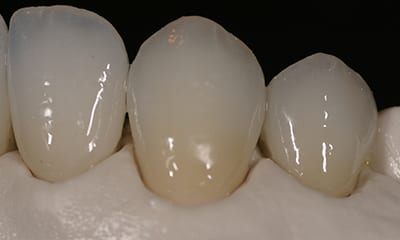
During Lab Work After Porcelain Crowns
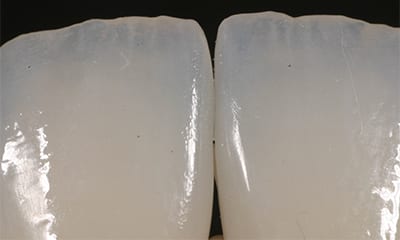
After Lab Work After Porcelain Crowns

Does that depend on how much tooth structure is left? If porcelain is bonded to the tooth structure, it will become one with the tooth structure. The technique to bond the crown to the tooth structure requires more time and it is more technique sensitive, depending on the preparation of the tooth structure if it is below the gum line, or above the gum line. Cementing crowns are much easier, however, the dentist must make sure that there is enough retention of the prepared tooth structure for the crown to last a long time!
To date, Zirconia crowns can only be cemented vs Emax crowns which can be both cemented and bonded.
When Should A Crown be Replaced?
Crowns may need to be replaced due to 2 main reasons:
1- Aesthetic and cosmetic needs, such as if the color is not right, or you desire to have the shape different, or the alignment is not right (it just does not fit your face and smile).
2- If the Crown due to health reasons needs replacement, causing sensitivity to temperature, the fit of the crown is compromised, which can cause decay and periodontal problems.
A thorough check by an expert dentist will guide you when to change or not change.
If a front Crown, needs to be redone, what is the best Porcelain option?
To replace one front crown is one of the most challenging treatments for any cosmetic dentist.
If your tooth has been root canal before and does have a post, that even makes it harder for the cosmetic dentist. The only way to block the color underneath 100% is to use porcelain fused to metal crown, and modify that with all-porcelain margins not to show any discoloration.
If your tooth is not dark underneath, no root canal, then possibly Emax crown (Lithium Disilicate) is a good fit. The Emax crowns are more translucent and more natural-looking, they are not bright and opaque, as opposed to Zirconia crown or Lava crowns. Zirconia is a white extremely hard metal! Lava or Zirconia crown is a white metal extremely strong, however, they will not match your teeth if you do have translucency on your adjacent teeth.
Lava or Zirconia will be a restoration of choice for an implant-supported porcelain crown, due to the strength, but they are so bright and white in which it is not recommended for natural-looking smiles. Make a consultation appointment, at that appointment, your bite and occlusion will also need to be analyzed to see which type of crown will benefit you the best.
All crowns are done with unparalleled perfection at Dr. Mobasser’s dental practice in Los Angeles. The custom crown depends on both aesthetics and function of each individual patient, he loves to provide the best crown for your needs, so they look naturally white and feel so good that you may forget you ever had a bad tooth. Modern, innovative technology, and finding the root cause of your problem is an integral part of Dr. Mobasser’s dental practice.

Choosing the right color of teeth: Special technique is to mask the gums with a gray shade to better see the chroma, and hue for choosing the right color
How much does a Dental Crown Cost?
Dental Crown cost depends on the knowledge and the expertise of the treating dentist and the complexity of the case. The price usually varies depending on if the crown is in front of the mouth or the back teeth, and do you show gums upon smiling? What is the track record of the dentist? How many Ceramic Crowns has he done? And how long on average his Crowns last?
The expert dental Laboratory and the master ceramist working with the dentist can significantly increase the price, since custom work such as shaping and exact matching of the color to the adjacent teeth, can vary the cost of your porcelain crowns. The cost of Crowns can also vary on the number of Crowns needed, the complexity of the case, the material cost, cosmetic needs, your bite (occlusion), and the original health of the tooth needing Crown.
Typically, the cost of average Porcelain Crowns done by an average dentist in Los Angeles and Beverly Hills is between $2000 to $3500, however the price increases depending on the expertise, knowledge, reputation of how long this dentist crowns last, the severity of each case, and the cosmetic needs of the individual patient.
The cost of Crowns is also dependent on the amount of custom work required by Dr. Mobasser and his Master ceramist, to match colors, give you a natural proportional shape to match your face, lips to provide you your dream smile. The cost can also depend on the complexity of each crown, depending on the color, shape, the bite, the color of the original tooth prior to starting, the bite and occlusion, and how fast you need to get your new crown is vital, some want their crown in few days some do not mind waiting a month.
If the Crown needs to be redone, the cost varies depending on what type of porcelain was used. Generally, to redo a Zirconia or an Emax crown costs more than to redo a regular crown, due to the amount of time required to cut off these stronger crowns. If you had a post and root canal, in the front tooth and you are not happy with the dark color showing through, the cost to redo that crown is more. If you do require a crown a comprehensive evaluation is needed prior to determining what type of crown best fits your needs.
The huge array of new materials and innovative techniques has eliminated the pain and discomfort of dentistry of the past. The ability to turn a badly broken-down mouth or worn-out dentistry into a healthy mouth is one of the most gratifying services for Dr. Mobasser. Through exceptional, keen eyes, vision, and his knowledge of over 30 years in dentistry, Dr. Mobasser is able to give patients another chance to enjoy their teeth for many more years and to provide that celebrity smile you always dreamed of, to last a long time.
How to choose the best Color for my Porcelain Crowns?
You must be happy with the color of Crowns you are getting. That is why the cosmetic dentist will have a consult with you regarding the final color you desire. Once the color is selected you get exactly that color YOU selected. Now if for any reason you do not feel comfortable with the final color you selected, ask your dentist if they can be altered, which may be an additional cost.
In general, the final color depends on 3 main factors:
1 – The preparation of the teeth by your dentist
2 – The porcelain material selected, and
3 – The artistic ability of the master ceramist!
Some Crowns such as Empress, or Emax may show a lot more translucency, compared to Zirconia crowns or Lava crowns, which reflect light, and they look whiter and more opaque. Having said that the shaping of your teeth by your cosmetic dentist is vital, for the ceramist to block out enough room for the final color of porcelain. In some cases, the cosmetic dentist might not sacrifice your tooth structure, not to damage the nerve of your tooth, in those cases the cosmetic dentist might be sacrificing the cosmetic but caring more about the health of the tooth, to avoid Endodontic treatment.
What to do if I need a Crown and possible Root Canal?
No worries, crowns can be repaired if root canal access is needed. Having said that, it depends on how picky you are as far as repair to your crown (after the root canal was done), with dental bond, in which can discolor vs you want to have an untouched porcelain surface. However, if the dentist or cosmetic dentist is predicting a possible root canal and you do not have pain or discomfort, usually the patient does not want to do a root canal first UNTIL a discomfort arises, and you have been informed.
If Endodontic treatment is needed, going through the crown to have an access opening for a root canal is simple for an experienced dentist or Endodontist, there should be no shattering of the crown, and it can be REPAIRED only. If you are OK with that and it is not visible, the majority of patients accept that and usually do the root canal when symptoms arise. If, however, you want your new crown not to be repaired then do a root canal first.
One other note, your dentist will definitely inform you if you must do a root canal due to an infection, those cases it is a must to do root canal prior to placing your crown, since the health of your tooth is involved, and there is clear cut infected nerve, vs borderline root canal therapy.
Porcelain Crowns Before & After
The above pictures, show Before and After pictures of ceramic crowns. The teeth were short, but lengthened with a dental crown, also the internal staining of teeth was corrected using hand stacked porcelain. Crowns were used due to decay and tetracycline teeth staining in conjunction with short front teeth, and worn out teeth due to biting, Patient was a grinder and had a clenching habit and a strong ceramic crown restoration was necessary, to make the front teeth younger looking.
Why Do My Porcelain Crowns Keep Coming Out? What Can Be Done?
These are the 6 major reasons why your crown keeps coming off:
1 – The number one reason for Dental Crown keeps coming off is lack of retention, and tooth structure to hold the crown without the cement. Your tooth might have been over-prepared period, and if there is not much tooth structure left the crown keeps popping off, there are possible ways to correct the underlying tooth structure.
2 – There could be decay, eating away the tooth structure, and yes, a tooth that has been crowned can get a cavity, coming from the root, or possibly all the decays have not been cleaned up.
3 – Your Crown fit is not perfect, and it is not fitting your tooth properly.
4 – Your bite on the Crown is not adjusted, you are putting extra excessive forces on the crown while chewing, and the occlusion on the Crown is wrong.
5 – Your Crown has been cemented vs bonded to the tooth structure, or possibly you have a post and root canal which was not fabricated properly. Note that Feldspathic porcelain needs to be bonded, Emax crown can be both cemented and bonded, and Cerec Zirconia crowns are safer to be cemented.
6 – Your Crown length and width cannot be supported by the root and prepared tooth! Meaning it is bulkier than your original tooth, if your crown is bulky and the tooth is not prepared properly by the dentist the crown will exert unnecessary pressure on the tooth causing it either to come off, get loose or possibly damage the nerve.
Note: If you have a temporary crown, and it came off and you cannot reach the dentist, it is best to put the Crown back in, or get temporary cement from the pharmacy to cement in, till you see your dentist! If you do not, the tooth can shift and compromise the final crown cementation.
How long do Porcelain Crowns last?
We have done many Porcelain Crowns; one case, in particular, has been in our patient’s mouth for 38 years and still looking good and functioning well. Our patient has been followed up regularly with routine checkups and maintenance, which is important to extend the life of your crowns.
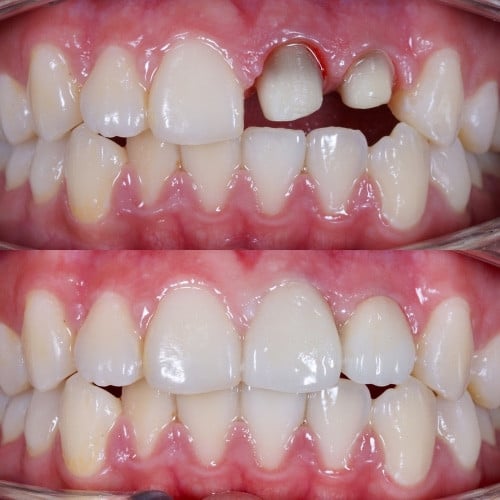 The Ceramic Crown is doing great, but due to age there is gum recession, but other than that they are doing well. Per the American Dental Association (ADA), it is suggested that Porcelain Crown longevity is about 5 to 15 years, however, a lot depends on which dentist is performing the crown procedure, the expertise of the dentist, and of course, the patient’s oral hygiene, how often they visit their dentist, unseen trauma, and functional habits such as clenching, grinding, the PH of their mouth (the acidic environment), and their bite and function.
The Ceramic Crown is doing great, but due to age there is gum recession, but other than that they are doing well. Per the American Dental Association (ADA), it is suggested that Porcelain Crown longevity is about 5 to 15 years, however, a lot depends on which dentist is performing the crown procedure, the expertise of the dentist, and of course, the patient’s oral hygiene, how often they visit their dentist, unseen trauma, and functional habits such as clenching, grinding, the PH of their mouth (the acidic environment), and their bite and function.
Which is better Porcelain or Ceramic Crown?
Cosmetically all Porcelain Crown (with Feldspathic Porcelain) is much better looking, lifelike than pressed or CAD/CAM ceramic crowns, however, they are not as strong as the pressed or CAD/CAM ceramic crowns, which are Emax (Lithium Disilicate) or Zirconia ceramic crowns which have different optical properties.
In patients with a history of crown fractures, severe clenching, or grinding, stronger ceramic porcelain is recommended. However, for front teeth depending on your bite, a feldspathic porcelain crown is the Gold standard. Nowadays the Dental laboratories tend to favor Ceramic Crowns which are milled or pressed since it does not take as much time as the Feldspathic Porcelain.
The dental cosmetic needs and function of the individual patient must be considered as a whole, in order for an expert cosmetic dentist to decide which one to use. The top cosmetic dentist usually has a master ceramist, that with proper instruction from the dentist, they can create beauty and functionality by combining both materials together and deliver a magnificent porcelain restoration for their patients.
Can your Porcelain Crowns be shortened, if they’re too long?
Porcelain Crowns can be shortened, depending on how much? If there is a nice translucency at the edge of teeth created, the patient must know they might be losing that translucent effect, also re contouring the crown must be done with an expert dentist, so after shortening one crown, the dentist can recreate the edges to mimic the adjacent teeth! If the crown is a monolithic Zirconia, the task will be more challenging due to the high strength of the porcelain. It is always possible to shorten a Porcelain Crown but adding length to the existing Porcelain Crown requires a redo of the crown.
Are Porcelain Crowns permanent?
Generally speaking, crowns are permanent porcelain restorations and can last north of 30 years if it is well taken care of. However, know that nothing lasts forever, depending on many factors such as patient oral hygiene, the acid environment of their mouth changing, gum recession, bone loss, trauma, or grinding and clenching habits, systemic medical condition among many more factors.
Are Porcelain Crowns stronger than teeth?
Porcelain crowns are by far stronger than teeth and do not usually wear down. Be aware that on a patient with a bad bite or occlusion, or with para-functional habits such as grinding and clenching, the opposing teeth can wear down, and dentin exposure with loss of enamel can be encountered. On those occasions, it is highly advised to wear a guard splint or nightguard to avoid the destruction of opposing teeth.
Can porcelain crowns break?
Unfortunately yes. Although Porcelain is much stronger than natural enamel, it can break due to excessive forces of the bite (occlusion), or trauma. Nowadays with the advent of Emax Porcelain Crowns which is 4 times stronger than natural Porcelain or Zirconia porcelain crowns which can be 7 to 8 times stronger than regular porcelain crowns there is way less fracture even with para-functional habits such as grinding or clenching. One disadvantage to Emax crowns or Zirconia crowns are possible tooth sensitivity or possibly movement of the tooth, causing space to the adjacent tooth since they do not give, and the forces of the bite can transmit the pressure to the nerve causing sensitivity or can cause movement of the entire tooth causing food to be stuck between teeth!
Can Porcelain Crowns be whitened?
Porcelain Crowns once cemented in the mouth cannot be whitened, nor if they are too white can be changed. It is important to get the Porcelain Crowns desired prior to cementation since the color can be altered and modified by the ceramist prior to the dentist cementing the porcelain crown. This concept goes also with any porcelain restoration such as Dental Veneers, inlays onlays, and Veneer overlays.
Do Crowns for front teeth look natural?
That depends on which dentist is doing them and which master ceramist is used. The front teeth crown can look very natural depending on the vision, dexterity, and knowledge of the expert dentist.
Note that natural teeth have polychromatic colors, and they are not monochromatic, meaning there are many colors incorporated in the tooth color to reveal the natural look. It is much easier for the laboratory to make teeth that are one color, rather than using the artistic skill to make them naturally light and add translucency to the porcelain to make it look natural.
Pain under new Crown with Root Canal Tooth?
If you have pain after placing a new crown on a Root Canal tooth upon chewing, the best dental treatment is to see your dentist for possible bite (occlusal) adjustment and an x-ray.
Usually, after bite adjustment, the pain subsides, however, if the root canal was not properly done, usually after placing a new crown, especially with the stronger crowns, such as E max, or Zirconia crown, the tooth can flare up, and even cause infection, and make a chronic infection with no pain turn to an acute painful infection.
Meaning a tooth that had no pain or discomfort, got agitated due to new biting forces. An expert dentist must always anticipate this problem when crowning a tooth with an unsatisfactory Root Canal, so that is why he will usually refer you to an Endodontist to redo an unsatisfactory root canal prior to placing a new crown.
If You do have sensitivity to hot and cold, it is very possible that an adjacent tooth or an opposing tooth may need dental treatment, which can be verified by x-ray, and clinical examination.


Before and After Dr. Mobasser’s One Front Porcelain Crown
Above: One front tooth, Emax Porcelain Implant Crown was fabricated to mimic the shape, color, symmetry, and alignment to a neighboring front tooth. Although the abutment post is in Zirconia, in order to match the color to the adjacent front tooth, Emax Crown was used. To Crown, one front tooth is the hardest task for any dentist and master ceramist. Custom work is required to get perfection and awesome result.
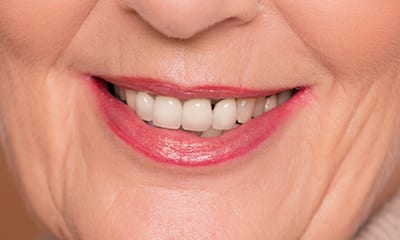

Before and After Dr. Mobasser’s Beautiful Emax Porcelain Crown
Porcelain Emax crowns were used to give patient, Fuller Smile and close the black triangle

Discolored, chipped, crooked teeth, worn-out teeth. The patient wanted more fuller natural white translucent teeth. After: Gleaming White Porcelain Crowns. Notice the change in alignment, a fuller smile, and teeth following the curvature of the lower lip, for maximum Aesthetic results


Before and After Dr. Mobasser’s Porcelain Crown Front Tooth
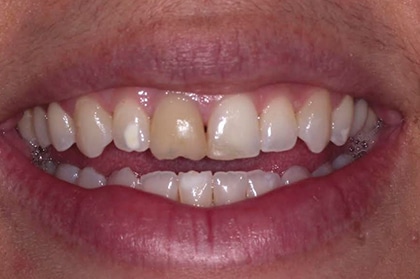

Before and After Dr. Mobasser’s Porcelain Crown Front Tooth


Before and After Dr. Mobasser’s Porcelain Crown Front Tooth

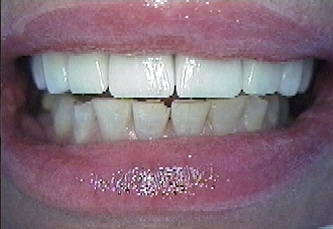
Before and After
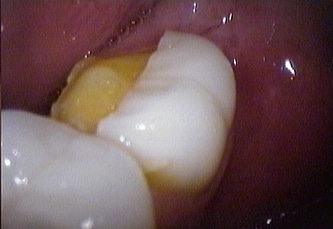

Emax crown fractured due to heavy bite, Dental bond can be used to repair. Ideally, it is better to get a new Emax crown

 Synopsis for Above: Patient presented with worn out crowns on two front teeth and veneers on 2 side front teeth. The combination of Zirconia Crown and Zirconia Veneers was fabricated by our cosmetic dentist in Los Angeles, to give the patient natural white color, natural shape, with perfecta imperfecta to mimic nature. The patient was incredibly happy.
Synopsis for Above: Patient presented with worn out crowns on two front teeth and veneers on 2 side front teeth. The combination of Zirconia Crown and Zirconia Veneers was fabricated by our cosmetic dentist in Los Angeles, to give the patient natural white color, natural shape, with perfecta imperfecta to mimic nature. The patient was incredibly happy.